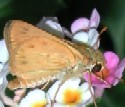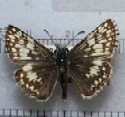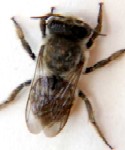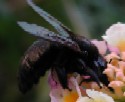Phyleus Skipper
White Checkered Skipper
Paper Wasp
A Closer Look at Lantana - in Phoenix, Arizona
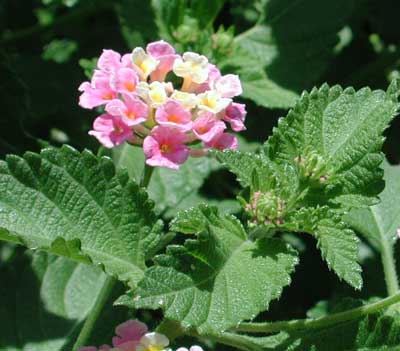 In the common area
of our townhouse community there are several lantana bushes. Insect life is
particularly abundant around these plants in part because of the nectar supply
in the flowers. Butterflies are especially well designed to extract the nectar
from the deep tubes; they can unfurl their long, coiled proboscis for insertion
into the tube. (Click the skipper butterfy thumb at left and you will be able
to see its long 'tongue' sipping nectar.) Honey bees, Digger Bees, Leaf Cutter
Bees, Paper Wasps and Thread-wasted Wasps also come in search of nectar but
often can't reach it; their mouthparts are simply too short. Some of these
visitors attempt to get to the nectar in a few florets, are frustrated and
depart while others become 'nectar thieves' by chewing a hole through the base
of the floral tube. Ecologists refer to this as thievery because the
pollination mechanism has been bypassed: The reward has been taken without
providing the service.
In the common area
of our townhouse community there are several lantana bushes. Insect life is
particularly abundant around these plants in part because of the nectar supply
in the flowers. Butterflies are especially well designed to extract the nectar
from the deep tubes; they can unfurl their long, coiled proboscis for insertion
into the tube. (Click the skipper butterfy thumb at left and you will be able
to see its long 'tongue' sipping nectar.) Honey bees, Digger Bees, Leaf Cutter
Bees, Paper Wasps and Thread-wasted Wasps also come in search of nectar but
often can't reach it; their mouthparts are simply too short. Some of these
visitors attempt to get to the nectar in a few florets, are frustrated and
depart while others become 'nectar thieves' by chewing a hole through the base
of the floral tube. Ecologists refer to this as thievery because the
pollination mechanism has been bypassed: The reward has been taken without
providing the service.
On July 1st the outside air temperature was close to 45°C, but when I measured the temperature within a leafy lantana shrub I measured 34°C. This cooling is provided by water evaporation from the leaves and there is shade to boot. Birds, lizards and insects thus can find some relief there.
Common Butterflies Appearing at Lantana
- Painted Lady (Vanessa cardui) -- Bright orange butterflies with black markings are very common during the fall to early spring months. They migrate far and wide and effectively pollinate the flowers. Throughout the winter, as a result, the bushes produce many blue-black berries, which are an important food source for Northern Mockingbirds. These birds then disburse the lantana seeds through their droppings. All three organisms, the bird, the butterfly and the lantana bushes, benefit from this relationship.
- Phyleus Skipper (Hylephila phyleus) -- A bright tawny orange butterfly with less than an inch wingspan. Females have the wings marked with more dark brown/ black than the males. They flit around quickly, but if you hold still they will return and you should be able to see the proboscis unfurl as it is inserted down the floral tube. The caterpillars feed on various grasses, Bermuda Grass being a favorite.
- Alfalfa Butterfly (Colias eurytheme)-- These orange-yellow butterflies are 2" wide and marked with a black band around the outside border. The black border on the male is solid whereas the female's has yellow spots interspersed. Alfalfa Butterflies are sometime very abundant near the Valley's alfalfa fields as the caterpillars feed on this plant.
- Checkered Skipper(Pyrgus albescens) --About an inch across, this, less common, butterfly is checkered black and white.
- Giant Swallowtail (Papilio cresphontes) -- This large dark brown and yellow spotted butterfly is very conspicuous.
Where there are more butterflies, lantana will set more fruit (berries which are eaten by birds). The flowers are really designed to be pollinated by lepidoptera (mothes and butterflies).
Why not try some real wildlife observation yourself? Start by standing really close to the bush (Best if you have a tall "wild type" lantana, as opposed to one of the low growing hybrids.) while waiting for the butterflies to return. Don't worry about the wasps or bees. They'll leave you alone if you're not literally trying to crush them. Soon you will begin seeing the many smaller insects that live on lantana. Most conspicuous are the iridescent green Long-legged Flies (Dolichopodidae). These gems dart quickly from leaf to leaf, doing a rapid run around each. The larvae of these beneficial insects are predaceous, feeding on tiny insects in the turf.
Whiteflies (Aleyrodidae: Bemisia) are present. At first there appears to be just a few of the white snowflakes flitting about. Looking at one average leaf under a microscope though, I fount 130+ whiteflies. These insects are not flies at all, but rather sap-sucking bugs related to aphids. All stages except the adults are sessile (can't move), which makes them vulnerable to predators. Pale Green Lacewing eggs, less than one millimeter, may be found perched atop a fine filament. The larvae devour many whiteflies as they grow. Without a powerful hand lens you will probably miss the most effective predator of the whiteflies, Encarsia. Much smaller than a period and straw colored, this minute wasp injects an egg through a long tubular ovipositor directly into a developing whitefly. After consuming the insides, an adult wasp emerges from the empty shell. Under a scope the parasitized whiteflies are noticeably darker.
The sap that the whiteflies pull from the leaves is not particularly nutritious. They have to process a lot of it in order to grow and reproduce. Sap's got plenty of water and sugar but very little protein. Thus a waste product, called Honeydew, consisting of water and sugar is expelled from the whitefly's posterior as they feed. Ants, especially Forelius, range over the leaves scraping up this sugary substance. Other minute flies and wasps join in feasting on the sticky, shiny substance.
Quite a few of the lantana leaves will have brownish splotches about a 1/4-inch across. A leaf mining insect has eaten away the tissue between the upper and lower epidermis. With a hand lens and a fine pin, you may be able to peel away the top layer and expose the minute larva. With all these insects feeding upon the lantana, you'd think it would be hurting. Yet the landscapers have quite a time keeping the lantana shrubs under control. First, most plants can withstand a lot of herbivores munching them before they show any signs of hardship. Second, most of the insects are eaten by other insects, spiders and birds before they get big enough to do much damage. So rather than dousing your lantana with poisons, why not take a closer look and see what mysteries are going on. Don't forget your sun hat and a hand lens, as the fascination may keep you longer than you might have expected!

